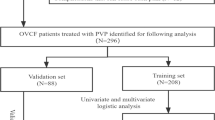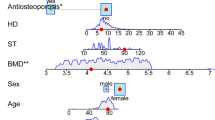Abstract
Background
This study aims to evaluate the risk factors of refracture in elderly patients with osteoporotic vertebral compression fracture (OVCF) patients after percutaneous vertebroplasty (PVP) and construct a predictive nomogram model.
Methods
Elderly symptomatic OVCF patients undergoing PVP were enrolled and grouped based on the development of refracture within 1 year postoperatively. Univariate and multivariate logistic regression analyses were performed to identify risk factors. Subsequently, a nomogram prediction model was constructed and evaluated based on these risk factors.
Results
A total of 264 elderly OVCF patients were enrolled in the final cohort. Among these, 48 (18.2%) patients had suffered refracture within 1 year after surgery. Older age, lower mean spinal BMD, multiple vertebral fracture, lower albumin/fibrinogen ratio (AFR), no postoperative regular anti-osteoporosis, and exercise were six independent risk factors identified for postoperative refracture. The AUC of the constructed nomogram model based on these six factors was 0.812 with a specificity and sensitivity of 0.787 and 0.750, respectively.
Conclusions
In summary, the nomogram model based on the six risk factors had clinical efficacy for refracture prediction.





Similar content being viewed by others
Data availability
Please contact the corresponding author for data requests.
References
Bone HG, Wagman RB, Brandi ML, Brown JP, Chapurlat R, Cummings SR et al (2017) 10 years of denosumab treatment in postmenopausal women with osteoporosis: results from the phase 3 randomised FREEDOM trial and open-label extension. Lancet Diabetes Endocrinol 5(7):513–523
Goldstein CL, Chutkan NB, Choma TJ, Orr RD (2015) Management of the elderly with vertebral compression fractures. Neurosurgery 77(Suppl 4):S33-45
Chen XS, Jiang JM, Sun PD, Zhang ZF, Ren HL (2020) How the clinical dosage of bone cement biomechanically affects adjacent vertebrae. J Orthop Surg Res 15(1):370
Voormolen MH, Lohle PN, Juttmann JR, van der Graaf Y, Fransen H, Lampmann LE (2006) The risk of new osteoporotic vertebral compression fractures in the year after percutaneous vertebroplasty. J Vasc Interv Radiol 17(1):71–76
Feng L, Feng C, Chen J, Wu Y, Shen JM (2018) The risk factors of vertebral refracture after kyphoplasty in patients with osteoporotic vertebral compression fractures: a study protocol for a prospective cohort study. BMC Musculoskelet Disord 19(1):195
Li W, Wang H, Dong S, Tang ZR, Chen L, Cai X et al (2021) Establishment and validation of a nomogram and web calculator for the risk of new vertebral compression fractures and cement leakage after percutaneous vertebroplasty in patients with osteoporotic vertebral compression fractures. Eur Spine J 31(5):1108–1121
Buchbinder R, Johnston RV, Rischin KJ, Homik J, Jones CA, Golmohammadi K et al (2018) Percutaneous vertebroplasty for osteoporotic vertebral compression fracture. Cochrane Datab Syst Rev 4:CD006349
Zhang ZL, Yang JS, Hao DJ, Liu TJ, Jing QM (2021) Risk factors for new vertebral fracture after percutaneous vertebroplasty for osteoporotic vertebral compression fractures. Clin Interv Aging 16:1193–1200
Stevenson M, Gomersall T, Lloyd Jones M, Rawdin A, Hernandez M, Dias S et al (2014) Percutaneous vertebroplasty and percutaneous balloon kyphoplasty for the treatment of osteoporotic vertebral fractures: a systematic review and cost-effectiveness analysis. Health Technol Assess 18(17):1–290
Li H, Yang DL, Ma L, Wang H, Ding WY, Yang SD (2017) Risk factors associated with adjacent vertebral compression fracture following percutaneous vertebroplasty after menopause: a retrospective study. Med Sci Monit 23:5271–5276
Lee BG, Choi JH, Kim DY, Choi WR, Lee SG, Kang CN (2019) Risk factors for newly developed osteoporotic vertebral compression fractures following treatment for osteoporotic vertebral compression fractures. Spine J 19(2):301–305
Yoo JI, Ha YC, Park KS, Kim RB, Seo SH, Koo KH (2019) Incidence and mortality of osteoporotic refractures in Korea according to nationwide claims data. Yonsei Med J 60(10):969–975
Mao W, Dong F, Huang G, He P, Chen H, Qin S et al (2021) Risk factors for secondary fractures to percutaneous vertebroplasty for osteoporotic vertebral compression fractures: a systematic review. J Orthop Surg Res 16(1):644
Ma X, Xing D, Ma J, Wang J, Chen Y, Xu W et al (2013) Risk factors for new vertebral compression fractures after percutaneous vertebroplasty: qualitative evidence synthesized from a systematic review. Spine. 38(12):E713-22
Kaufman JM, Palacios S, Silverman S, Sutradhar S, Chines A (2013) An evaluation of the fracture risk assessment tool (FRAX(R)) as an indicator of treatment efficacy: the effects of bazedoxifene and raloxifene on vertebral, nonvertebral, and all clinical fractures as a function of baseline fracture risk assessed by FRAX(R). Osteoporos Int 24(10):2561–2569
Ling MP, Huang JD, Hsiao HA, Chang YW, Kao YT (2020) Risk assessment of the dietary phosphate exposure in taiwan population using a total diet study. Foods 9(11):1574
Matias PJ, Laranjinha I, Azevedo A, Raimundo A, Navarro D, Jorge C et al (2020) Bone fracture risk factors in prevalent hemodialysis patients. J Bone Miner Metab 38(2):205–212
Chen L, Zhang J, Zhang W, Deng C (2020) Correlation between C-reactive protein/albumin and contralateral hip refracture after total hip arthroplasty in elderly patients with hip fractures. Ann Palliat Med 9(3):1055–1061
Jiao J, Wang JW, Xiao F, Huang YC (2016) The association between the levels of CRP, IL-10, PLA2, Fbg and prognosis in traumatic fracture of lower limb. Exp Ther Med 12(5):3209–3212
Liu X, Yu Z, Wen D, Ma L, You C (2021) Prognostic value of albumin-fibrinogen ratio in subarachnoid hemorrhage patients. Medicine 100(17):e25764
Sun DW, An L, Lv GY (2020) Albumin-fibrinogen ratio and fibrinogen-prealbumin ratio as promising prognostic markers for cancers: an updated meta-analysis. World J Surg Oncol 18(1):9
Kuluozturk M, Deveci F, Turgut T, Oner O (2021) The Glasgow Prognostic Score and fibrinogen to albumin ratio as prognostic factors in hospitalized patients with COVID-19. Expert Rev Respir Med 15(8):1061–1068
Acknowledgements
None.
Funding
None.
Author information
Authors and Affiliations
Contributions
XQL participated in the conception and design, data collection, and statistical analysis; GJ wrote the manuscript and participated in the conception and design and data collection.
Corresponding author
Ethics declarations
Conflict of interest
The authors declare that they have no competing interests.
Ethics approval
This study protocol was approved by the ethics committee of Taizhou People’s Hospital. All patients included were required to offer written informed consent.
Consent for publication
Not applicable.
Additional information
Publisher's Note
Springer Nature remains neutral with regard to jurisdictional claims in published maps and institutional affiliations.
Rights and permissions
Springer Nature or its licensor (e.g. a society or other partner) holds exclusive rights to this article under a publishing agreement with the author(s) or other rightsholder(s); author self-archiving of the accepted manuscript version of this article is solely governed by the terms of such publishing agreement and applicable law.
About this article
Cite this article
Ju, G., Liu, X. A nomogram prediction model for refracture in elderly patients with osteoporotic vertebral compression fractures after percutaneous vertebroplasty. Eur Spine J 32, 3919–3926 (2023). https://doi.org/10.1007/s00586-023-07843-w
Received:
Revised:
Accepted:
Published:
Issue Date:
DOI: https://doi.org/10.1007/s00586-023-07843-w




